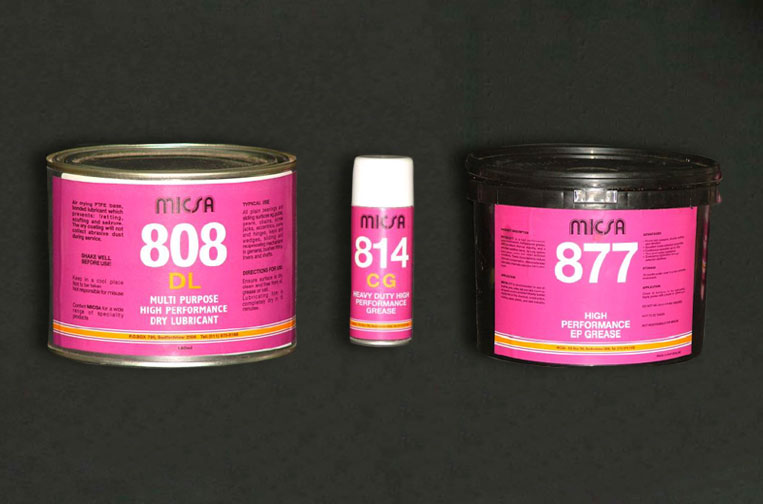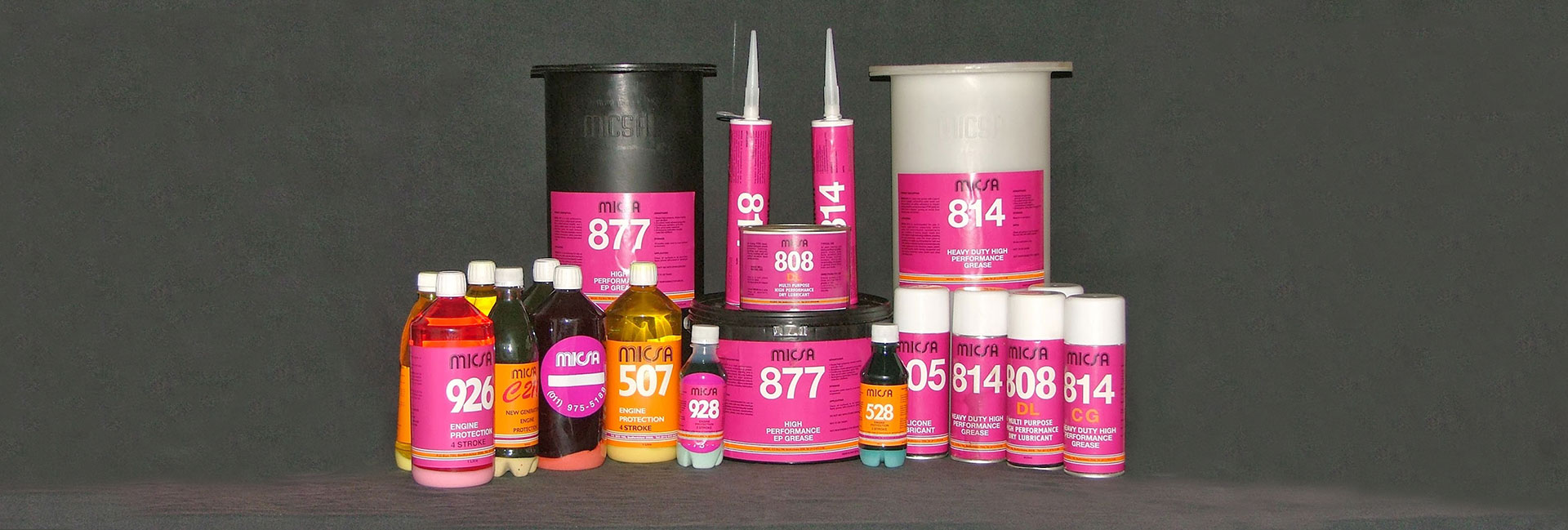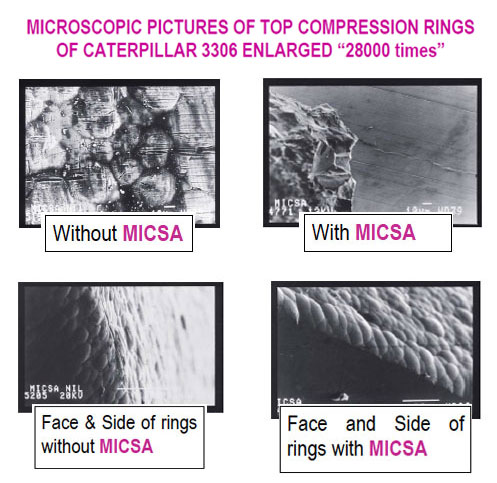
ENGINE TREATMENT / GREASE
Bru-Force, the sole distributors of MICSA for Africa
What is MICSA
MICSA is an Swiss based company that has been in South Africa since as early as 1979. MICSA South Africa has the Sole distribution of MICSA products across Africa.
MICSA is a completely new technology with its closest affinity being high quality synthetic oils.
MICSA is not an additive in the normal sense of word as it does not in anyway change the characteristics of the primary oil or lubricant agent but rather, it is a high quality metal conditioner that lubricates any working part or machine thereby reducing friction and ultimately wear and tear. The MICSA range are breakthrough lubricants, greases have successfully been marketed to the industry worldwide.
The high value of MICSA for Industrial Maintenance has been proven over and over by many well known industrial companies and has been used successfully in vehicle, aviation, fleet, marine, and motorcycle, firearm and industrial applications. MICSA is THE ONLY concentrated polymer/metal conditioner that has successfully penetrated the industrial market world-wide and even more importantly has been proven to be completely safe in metal-to-metal friction environments with not one report from industry indicating a detrimental effect or negative outcome. Simply stated MICSA’S Lubricant. Grease and Treatment series are by far the most revolutionary metal conditioner and protective friction reducing products available today.
CONTACT BRU-FORCE FOR DETAILS
MICSA GREASE


TECHNICAL FORMULATION OF MICSA GREASE
Some of the best greases in the world contain advanced anti-wear agents, top quality polymers, high-viscosity base oils, lithium-complex soap thickeners and natural rust inhibitors. What sets MICSA GREASES apart is that in addition to these top class ingredients MICSA adds the substance with the lowest co-efficient known to man Polytetrafluorethylene (P.T.F.E.) which is unique in its ability to form a physical and chemical bond within all metal surfaces, thereby reducing internal friction, heat and wear.
VERSATILITY
MICSA GREASES are exceptionally versatile. It can perform in varied adaptations from heavy-duty high performance applications such as CV joints pin & bush to water resistant, high temperature wheel bearings, sliding surfaces, guides gears and chains.
APPLICATIONS OF MICSA GREASE
Every industrial application, including drilling equipment, rock crushers, lumber mills, gravel and sand screens, conveyor belts, marine equipment etc. Every Fleet and Automotive application, including all, CV and Universal joints, steering gear, equaliser bar, hydraulic hammer, mobile cranes, water pumps etc. Every Agricultural, logging, mining, construction and technical application where maximum protection against extreme conditions is required etc.
SAVINGS USING MICSA GREASE
Due to the revolutionary inclusion of P. T.F.E. in MICSA GREASE, the product simply outperforms all other greases by extending equipment life, reducing downtime, improves efficiency and protects against unscheduled maintenance. MICSA GREASE will improve your profit margins by reducing maintenance costs, lowering energy usage, and dropping capital equipment replacement. Peace of mind when operating away from home base.
BENEFITS OF MICSA GREASE
The benefits of MICSA GREASE are vast and far outperform any “normal” grease:
- Prevent rust and corrosion
- Extends lubricating intervals
- Reduces, wear, galling
- Increases equipment life
- Reduces maintenance
- Superior shock load protection
- Excellent water washout resistance / water repellence
- Extremely wide variety of applications
- Is not displaced in severe conditions
- Extends bearing life
- Economical
808 DL Multipurpose grease
814 Heavy-duty grease
877 High-performance water-resistant grease
881 High-temperature wheel bearing grease
898 Copper Compound
Anti-Seize Compound
899 Nickel Compound
Anti-Seize Compound
TECHNICAL DATA:
Appearance stiff silver paste
Consistency
NLGI 3
Anti-seize solids
Nickel & Graphite
Temperature: -40°C - 1000°C
MICSA ENGINE TREATMENT


TECHNICAL ADAPTABILITY
APPLICATION OF MICSA ENGINE TREATMENT
BENEFITS OF MICSA ENGINE TREATMENT:
- Extends engine life due to less wear, minimal metal to metal contact
- Extra protection against fuel-oil dilution
- Improves fuel consumption
- Increased engine performance
- Improves compression
- Increased thermal efficiency
- Improves exhaust emission
- Minimises damage due to heat seizure
- Reduced friction of metal against metal
- Improves starting from cold
- Resistant to extremes of temperature
- Reduction of downtime
STABILITY OF PRODUCTS
One of the most essential characteristics of MICSA is its base of P.T.F.E., which is produced from a powder moulded freely by compression. It is a Fluorocarbon polymer whereby the main fluorescing is Polytetra Fluorethylene. P.T.F.E. is a plastic material with practically universal resistance of a Density 2-2, 3 and has the following outstanding properties:
- Low coefficient of friction
- Excellent mechanical resistance
- Almost chemically inert
- Non flammable
- Unique dry lubrication property
- Excellent corrosion resistance
- Excellent insulator
- Thermal stability from -100°C to 270°C
LONG TERM SAVINGS
EVOLUTION C211 PTFE base treatment
MICSA 507 PTFE base engine treatment
MICSA 926
- Micsa 926 is a liquid preparation consisting of P.T.F.E polytetrafluorethylene.
- 926 offers different grades of P.T.F.E
- They are all combined to give you the greatest protection against high temperatures and wear.
- Friction free operation due to P.T.F.E it is the substance with the lowest co efficient of friction of any material researched known to date.
- It operates in temperatures from 100 degrees Celsius to 290 degrees Celsius. And will operate for a short period of time at at maximum temperature of 450 degrees Celsius.
- When other lubricants have deteriorated into hard films.
JUST THE FACTS OF MICSA 926
Fuel savings involves three main areas:
• The immediate saving on a particular piece of equipment.
• The long term saving on that equipment
• The global saving on a fleet
These are obviously related but each involves different approaches and measurements. From the technical and financial viewpoint, whatever process is
followed, the result must be measurable in the normal financial feedback numbers. If the fuel saving process also has a marginal improvement on the engine power, the
operator will use the additional power to do the task quicker. This means that part of the saving will be a productivity improvement, not seen directly in the fuel figures.
TECHNICAL DATA
We know that MICSA 926 is not an oil ADDITIVE but an engine treatment, which is transported by the oil to all lubricated surfaces in the engine. One such surface is the cylinder wall. The layer of P.T.F.E., which is, deposited on the cylinder by the piston ring (see photo-micrograph), insulates the combustion gases “working fluid” from the water jacket. As P.T.F.E. has a very high thermal resistance, even although only 3 to 5 microns thick, it prevents a significant amount of heat passing to the cooling system. This heat remains in the combustion gases (working fluid), increasing the mean effective pressure on the piston, producing more work from the same amount of fuel injected. This is an improvement in the thermodynamic efficiency which is also being exploited by the use of ceramics in some engine developments to raise the pressure and temperatures. The P.T.F.E. also improves the seal between the piston, ring and cylinder by filling voids. This reduces “blow-by” which is simply a waste of energy (and fuel). The improved seal captures the combustion gases, retaining the pressures so they can do maximum work. The fuel saving is NOT a result of the reduction of friction between the piston, ring and cylinder wall. That friction only occurs at start-up when they are in contact. Once they start moving, hydrodynamic lubrication is established and ‘friction’ is governed by shearing of the oil film between them. Less viscous oil uses less power when running. This improvement is around 5% so it is not really visible in the day operation of equipment, but will show in the monthly figures. A secondary benefit from this insulating layer is that the working parts of the engine reach normal operating temperature sooner BUT the temperature gauge takes longer to register as less heat is entering the cooling system. These phenomena have been demonstrated during dynamometer tests.
MICSA 928
MICSA 930




Interested in MICSA Products ?
MICSA has the unique ability to work in the presence of water, solvents and other contaminants. It does this by giving the metal its own lubricating ability. Oil contamination destroys the oils ability to provide the necessary film strength for continued lubrication. The MICA treated metal surface can provide its own lubrication despite severely contaminated oil. MICSA has greatly reduced wear levels in engines with the result that equipment life is extended both through wear reduction and through avoidance of catastrophic failure.
MICSA improves efficiency and extends the life of this equipment. MICSA has been used extensively in coal mining. Coal dust is a frequent oil contaminant that causes parts to wear out quickly. MICS has been proven to dramatically extend the life of equipment despite coal dust intrusion
Discover all the benefits and savings when using MICSA Engine & Grease products.










